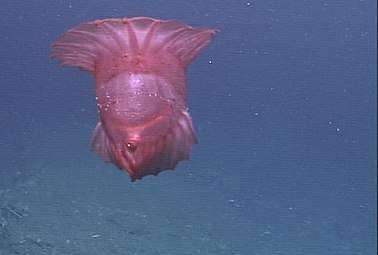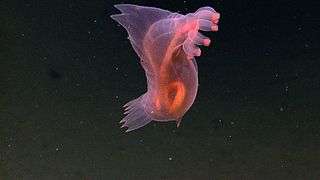Enypniastes
| Enypniastes | |
|---|---|
 | |
| Enypniastes sp. | |
| Scientific classification | |
| Kingdom: | Animalia |
| Phylum: | Echinodermata |
| Class: | Holothuroidea |
| Order: | Elasipodida |
| Family: | Pelagothuriidae |
| Genus: | Enypniastes |
Enypniastes is a genus of deep-sea sea cucumber.
Description and characteristics
Species in this genus have developed webbed swimming structures at the front and back of their bodies which enable them to swim up off the surface of the sea floor and to journey as much as 1000m up into the water column. This is thought to help the animals move to new feeding grounds and avoid predators.[1]
When Oceaneering ROV pilots saw and photographed the creature at 2500m depth they named it “The Headless Chicken Fish.”[2]
The Enypniastes, also known as Echinodermata: Holothuroidea, is a sea cucumber,. It ranges in size from eleven to twenty five centimeters.[3] Its most distinct feature is its coloring,which is dictated by size, small enypniastes are a bright pink and larger individuals are a more reddish brown color . It is also semi transparent and its intestine can be seen through its body, especially after feeding.[4] The enypniastes have a round bulbous body, bifurcated tentacles, and a large anterior sail (Miller J. E., David L. Pawson. 1990). They can also be bioluminescent.[5]
Habitat
The Enypniastes can be found mainly in the benthic region of the ocean. They can be found all over the globe in many different regions.[3] They spend most of their time in the water column only touching down on the seafloor to eat.[4]
Feeding
The Enypniastes feed mostly on benthic sediment. They feed by pushing food into their mouths with their tentacles. They feed very quickly, staying on the seafloor for at most sixty four seconds. Since that is most enough time to feed fully the enypniastes feed episodically.[4]
Movement
The Enypniastes move using a few methods. The first is that they move their anterior veil in a rowing motion. The second is that when there is a current, the organism will use their tentacles to pull themselves down current. They also move using a pushing motion with their tentacles.[4]
Species
Many species have been described in this genus, however they are now believed to be all synonyms of E. eximia:[1]
- Enypniastes eximia Théel, 1882 -- Pink swimming sea cucumber (only confirmed species to date)
- Enypniastes atlanticus (Heding, 1940)
- Enypniastes diaphana (Gilchrist, 1920)
- Enypniastes ecalcarea (Sluiter, 1901)
- Enypniastes obscura (Koehler & Vaney, 1905)
Notes
- 1 2 Miller, J. E.; Pawson, David L., Swimming Sea Cucumbers (Echinodermata: Holothuroidea): A Survey, with Analysis of Swimming Behavior in Four Bathyal Species, Smithsonian contributions to the marine sciences, no 35, 1990.
- ↑ http://www.oceaneering.com/category/oceaneeringnews/page/4/
- 1 2 Solís-Marín, Francisco Alonso; Hooker, Yuri; Laguarda-Figueras, Alfredo (2012-10-02). "Primer registro del pepino de mar nadador Enypniastes eximia Theel, 1882 (Echinodermata: Holothuroidea) en aguas peruanas". Revista Peruana de Biología. 19 (1): 095–096. ISSN 1727-9933.
- 1 2 3 4 Miller, J. E.; Pawson, David L. (1990-06-01). "Swimming sea cucumbers (Echinodermata: Holothuroidea): a survey, with analysis of swimming behavior in four bathyal species". Smithsonian Contributions to the Marine Sciences (35): 1–18. doi:10.5479/si.01960768.35.1. ISSN 0196-0768.
- ↑ Robison, Bruce H. (May 1992). "Bioluminescence in the benthopelagic holothurian Enypniastes eximia". Journal of the Marine Biological Association of the United Kingdom. 72 (2): 463–472. doi:10.1017/S0025315400037826. ISSN 1469-7769.
References
- Mah, Christopher (September 18, 2012). "Deep-Sea Swimming Sea Cucumbers and the "most bizarre holothurian species in existence"!". The Echinoblog.
- http://zipcodezoo.com/Animals/E/Enypniastes_eximia/
- The Blue Planet-http://www.bbc.co.uk/nature/blueplanet/factfiles/starfish_urchins/swimming_sea_cucumber_bg.shtml
| Wikimedia Commons has media related to Enypniastes. |

